#again just a stellar example of zelda at its best in so many ways
Text
GAME COMPLETED!
I need a hot minute before I gush... But oh my god, wow, this game was incredible. Not just a stellar handheld title, but a prime Zelda title as a whole. 9.9/10, for sure <3
#scrawny rambles#tloz#albw#anyhow i'm obsessed#i WILL be making memes in the aftermath#as always this is a zelda game and OH MY FUCKING GOD THE PLOT. JUST. look i've known all this for years but#yuga. hilda. their schemes. their dynamic. what the FUCK is up with them???#ravio my beloved freeloader god fucking bless and amen#i only wish that you had REARRANGED MY FURNITURE ONCE YOU SOLD OUT. FUCKER.#smh ravio ess-em-eych#everyone in that trio needs to be held by the nape and shaken to varying degrees#i 100%'d my file and died only nine whole times!! wow 🥰🥳#GOD. this MIGHT be the first time i've 100%'d a game ever#holy shit#but yeah OH MY GOD what a stellar fucking game#highly recommend#takes a little getting used to at first#but everything is so intuitive and so wonderfully designed#guiding without handholding#again just a stellar example of zelda at its best in so many ways#we STAN albw on this blog#even if turtle rock was a pain and i'm put-off by what they did with oren lmao
4 notes
·
View notes
Text
Completed: Castlevania
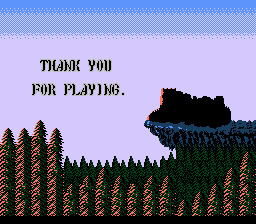
Boy, this feels ass backwards to talk about now.
So. “Castlevania.” You might have heard me talk a little bit about this series. Might marginally be a fan, particularly of the Igavania era. But, why haven’t I talked more about the NES incarnations? After all, it’s important to experience and discuss the origins of a video game series, particularly in the face of a recent revival in interest.
I think you need to understand that when it comes to platforming games, I’m a klutz. Like, so bad that I was convinced I was bad at ALL video games until I had an epiphany regarding practice and the potential for improvement (thank you, “Star Fox 64.”) Given “Castlevania”’s status as a famous platformer, I never thought I could tackle it. Its successors trounce it in difficulty, but “Castlevania” isn’t a pushover. Luckily, a little practice and muscle memory take the fangs out of it rather quickly.
I’ve said it once, and I’ll say it again. You don’t play old video games—you practice and preform them.
“Castlevania” is the story of the no-pants victory dance wonder Simon Belmont thigh-mastering his way up Dracula’s castle in the 1600s. Along the way, he wrecks a variety of bosses based on mythological creatures and 1930s Universal Pictures monster movies. The movie influence is particularly strong here, both in the game’s gag credits and title screen film-stock appearance. If popular NES games are based on some popular movie (i.e., “Metroid” and “Alien”, “The Legend of Zelda” and “Legend”, “Contra” and “Predator”, etc.), then this game is the moviest movie game to ever movie. It took whatever it could get its hands on and threw it into a party mix.
This wild variety of monsters is part of “Castlevania”’s staying power. Each has their own movement and attack pattern, ranging from simple horizontal navigation to erratic jumping, weaving, spitting, and teleporting. In conjunction with tricky monster placements are significant platforming threats, like mashing plates, bottomless pits, waterways, grinding gears, and stairs. So many stairs. No wonder Simon has globe-crushing thighs.
Simon comes with a classic set of tools—the Vampire Killer whip and one of several subweapons, including a knife, an axe, holy water, a stopwatch, and a cross. (Yeah, I know the instruction manual calls it a boomerang, but just look at the damn thing. Clearly, that’s some cool application of Christianity that Bibleman can’t compete with.) Most of the subweapons cost one heart to use, with the exception of the stopwatch (which requires five.) What you want to use is completely up to you, but thanks to its stun-locking potential, the holy water tends to be the weapon of choice for many situations. It’s totally okay to experiment to see what works the best for your playstyle and what boss you’ll be facing.
The game is consistent with its subweapon and whip upgrade drops from background candles, but on occasion, subweapons and upgrades can also be dropped from defeated monsters. Additionally, the game will give you money (read: points for your score) and hearts from these candlesticks. The game is basically telling you that if there’s a fire, you should put it out. It’s what Smokey the Bear would want you to do, anyway. And are you going to get into a fight with a bear? Dracula’s bad enough.
Simon is one of those video game characters that is unique due to his physics. Like, you ever see someone bitching about Sonic the Hedgehog not running or jumping correctly? Pretty sure you can make the same argument for Simon. That’s not to say they’re stellar, by any means. Dude jumps like a bag of bricks. However, his range and the strength of his hits makes him a viable character. Learning to play him is a good step in developing video game skills at large, especially with older games.
Yes, I could compare him to a fossil. But, you can learn a lot from fossils. Like, the evolution of flight, for example! (What are you—a tree-top-down or ground-floor-up speculator?)
Aesthetically, the game has aged well. The winning element by far is the musical composition. Several tunes from this game have been picked up and repeated throughout numerous “Castlevania” games throughout the years. They’re peppy—absolutely necessary for an NES game, if you’ve ever taken a peek at their audio software. (Never want to let that triangle channel rest for long!) About the only tune that sounds indistinguishable/worse than any other incarnation is this game’s rendition of “Heart of Fire.” Like, check out this compilation on Youtube. I can hardly tell it’s the same song as the GBA variant!
Though, if you want to hear a real disaster, perhaps you should check out the Commodore 64 port of “Castlevania.” Yikes on several levels, but especially audio.
I also think the visual design looks good, especially for the time. NES sprites were allowed three colors per an 8x8 pixel block (technically four, but one color was usually dedicated for transparency.) So, earlier games would have sprites with no line art using as many colors as possible in their composition. “Castlevania” was one of the first games to dedicate a single color for linework, then using the other two available colors judiciously. Such a style helped create a sharper and cleaner appearance. This went on to be a more popular style later in the NES’ life cycle, so it’s neat to see it being used relatively early on.
Really, the one weird visual thing that trips me up is the final form of Dracula. I don’t quite get where the whole blue demon imagery comes from, in terms of other media representations that this game follows. I guess I’d chalk it up to a Japanese mythological thing. Like, if he were an oni or something.
As far as cheap difficulty goes, the game does inflict more damage to Simon as the game goes on (starting with 2 pips of damage per hit in early stages and ending with 4 pips in the final stages.) Random enemy positioning can also wreck a playthrough, particularly in the beginning of Section 4 (Stage 10) and the middle of Section 6 (Stage 17.) However, I don’t think this game is completely unfair. It does its best to get Simon’s whip back to full blast after every death, and during the final encounter with Dracula, it will place the player in front of Dracula’s door (instead of forcing them through the entire section again.) Continues are also liberal. It might not mean much in this age of save states and reloading, but it’s nice that the game doesn’t kick you right back to the title screen after a series of failures.
Overall, this game earned its legacy through its character and monster designs, its musical score, and its manageable difficulty. Even with multiple versions available across several gaming platforms, the Nintendo variant was so damn popular and influential with the NES crowd that people still keep begging for Simon’s appearance in a Smash Bros. game. (Well, that, and it would have been a laugh to have a Captain N reunion.) I would recommend giving this game a shot, especially if you’re looking to appreciate a piece of the past. If a complete klutz like myself can get through it, I’m pretty sure most people can.
4 notes
·
View notes
Photo
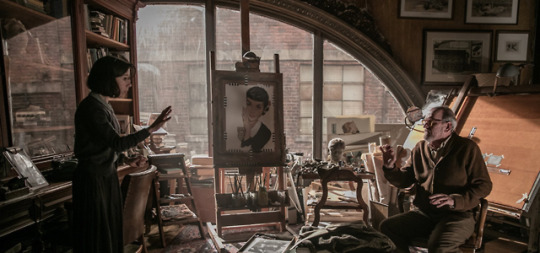
A Resounding Work of Cinematic Magic
(Review of ‘The Shape of Water’, seen in Nordisk Film Biografer Kennedy in Aalborg on the 22nd of February 2018)
It’s a heartfelt romance, an homage to classic monster films and a gritty cold war thriller. But above all, Guillermo del Toro’s The Shape of Water is a fairytale of the most magical kind. Del Toro who has struggled to gain appreciation for his work after fascinating us all with the stunning El Labyrinto del Fauno (2006), here returns to his winning formula from said film: a magical, escapist fairytale set against the backdrop of brutal, real world events. The Spanish civil war has been changed to the cold war and the space race between the US and the Soviets and in stead of the young Ophelia we follow middle-aged Elisa; a cleaning lady at a top secret US science facility. Apart from this, The Shape of Water is bursts with the same creative grandeur, fable-like imagination and heartfelt emotions that made El Labyrinto del Fauno such a hit. And yet, they are completely different films.
As already said, The Shape of Water, follows Elisa Esposito; a mute, whose shy and somewhat introvert personality suits her job as the cleaning lady, who has to simply just blend in and clean without observing or engaging with anything in the science facility she works in together with regular colleague Zelda. At home she spends her days with the same routines and usually together with her equally secluded neighbour, Giles, who is a now downcast artist living alone with his cats. One day, however, the regular routines and repetitive everyday life of Elisa is turned upside down as a new “asset” is brought into the facility; a strange man-like fishy creature with whom Elisa quickly forms a special bond centred around their common lack of speaking abilities. The asset, however, is shrouded in mystery as it is heavily guarded and tortured by new head of security, Richard Strickland, who is attached to find out what secrets the creature holds and how it can help the Americans win the space race with the Russians. As things escalate, all characters are forced to take a stand and decide which side they are on with the risk of grave, personal consequences.
As the main character, Elisa, Sally Hawkins delivers one of the most profound and stunning performances of recent years. To do so without uttering a single word throughout the film is a proof of just how good an actress she is. She perfectly captures the shy yet confident nature of the introvert Elisa as she suddenly finds a true confidant in the amphibian man who - with her own words - sees her for who she is and not what she lacks. Her performance is as powerful as it is heart-wrenchingly fragile. I, for one, completely believed in the character and her growing relationship to the odd creature; Hawkins’ mannerisms and use of body language was deeply fascinating and complex. A necessary level of performance for the film and story to work; casting when it is done to perfection!
Opposite her is the “two men in her life” (which is beautifully shown in a panning shot from outside their neighbouring apartments in the second half of the film) is veteran Richard Jenkins as Elisa’s neighbour Giles and Del Toro’s recurring “creature man” Doug Jones as the amphibian man. Jenkins turns in a scene stealing performance as the odd, suppressed gay friend who struggles to realise the exact nature of any of his interhuman relationships. He is also the comic relief in a quite a few instances and his chemistry with Hawkins is simply heartwarming. Jones, whose job is obviously somewhat hidden by the mix of prosthetics and CGI, manages to pour a lot of humanity into the scales of the water creature. His body language shifts fiercely from delicate curiosity towards Elisa to frighteningly brutality when threatened. Make no mistake; this is the work of Jones and a testament to abilities as an actor. He strikes a magical chemistry with Hawkins.
The remaining, stellar cast is made up of Octavia Spencer, Michael Shannon and Michael Stuhlbarg. Spencer, although slightly typecast, delivers her best performance since The Help as the constantly talking and loyal friend to Elisa, Zelda, who is often given the job of putting words to Elisa’s gestures. Shannon, however, is a manic powerhouse constantly balancing on the edge of blatant over-acting as the embodiment of the cynical America; demeaning towards each and every other character and brutally violent, he acts with such a nerve that he carries the cold war thriller aspect of the film on his perfectly capable shoulders. Opposite him in this part of the story, is Michael Stuhlbarg’s dubious doctor who faces the ethical dilemma of choosing between his chosen way in life or that of the mysterious, fascinating and beautiful creature that speaks to his scientific heart.
All in all, this is cast that strikes a near perfect chemistry between all the central characters making their omission from the SAG ensemble award (they weren’t even nominated) nothing but baffling!
They are, of course, all controlled by a firm, confident and most importantly loving hand from director and writer Guillermo del Toro. In his recent BAFTA acceptance speech he spoke about how monsters had saved him on several occasions and how, in many ways, there were his best friends. This love for and understanding of monsters, the obscure, runs through every vain of this film. It is a work of love and imagination with a level of sincerity towards its subject matter that is extremely refreshing in 2018 Hollywood due to the increasing rarity of exactly this. He is perhaps the best modern storyteller of fairytales and despite some issues here and there in the story (e.g. a slightly rushed initial romance and some lose elements) the overall magic of the film quickly made me forget about this. Fairytales has never been about waterproof storylines that has to be 100% believable; quite the contrary. The essence of a fairytale is the magic and the way it mirrors the real world and here, The Shape of Water, serves as no less than an exquisite example.
Be aware, though, that this is very much an adult fairytale. Where El Labyrinto del Fauno was seen from the perspective of a child, this is an adult film from start to beginning. Sexual tension and desire is recurring topic whether it is in Elisa’s daily bath routines, Giles’ misunderstood relation with the local café’s servant or Strickland’s need to control women. The sexuality of the story comes to a beautiful conclusion ultimately captured in a single shot of a bus window. The film also takes on many relevant political issues with suppressed individuality perhaps the biggest of them all: Elisa being an outsider due to her disability, Zelda experiencing racial discrimination, and Giles struggling to find acceptance for his sexuality. As highlighted by Octavia Spencer it is actually quite beautiful to see how the african-american woman and suppressed homosexual man becomes the voices of wisdom for the lonely Elisa as they take on the cynicism of the militarised world they live in.
Visually each and every frame of this film is pure eye candy thanks to the masterful cinematography by Danish Dan Laustsen (actually from my home town) and the imaginative, creative and beautiful production design by Paul D. Austerberry. The film has an estimated budget of just below $20,000,000, but the (mostly) physical sets looks like it was much more expensive than this, which is simply awe-inspiring in a time where CGI seems to be the main solution with budgets continuing to blow through the roof. The Shape of Water, is also a feast for the ears thanks to a whimsical, subtle and moving score by Alexandre Desplat, who once again shows why he is one of the absolute best in his field right now.
The film received no less than 13 Oscar nominations and is sure to go home with some of these. Whether it will win Best Picture or not is a big question (del Toro seems quite certain for Director), but no matter what del Toro has certainly found the appreciation he has longed for from Hollywood and it is a remarkable feat that this was done without the film feeling like anything but a del Toro film through and through. It’s a work of love and a celebration of the human nature. How should we deal with the darkness of the real world monstrosities? Del Toro’s answer always seems to be through the beauty and love of imagination. Thanks to this, he has created the perfect escape that simply HAS to be seen in the darkness of the cinema that hasn’t seen magic like this for years.
5/5
#Film#Film Review#Movie#Movie Review#Oscars#Oscars 2018#Academy Awards#Best Picture#Best Actress in a Leading Role#Best Supporting Actor#Best Supporting Actress#Best Director#The shape of Water#Guillermo del Toro#Sally Hawkins#Doug Jones#Richard Jenkins#Michael Shannon#Michael Stuhlbarg#Dan Laustsen#Alexandre Desplat#Paul D. Austerberry
2 notes
·
View notes
Text
VIDEO GAMES—Sunday Chats (10-29-17)
There are a lot of video games, and I haven’t done questions in a minute, so those too. Let’s get to it!
ExtraLife 2017

I wanted to throw a PSA in here that Irrational Passions, my “conglomerate” is throwing together our big special ExtraLife show for 2017 on November 11th, starting at 12pm Eastern Time, and we’ll be playing video games and live streaming them for 24 hours from then. It’ll be live over on twitch.tv/IrrationalPassions and myself and Roger Pokorny threw together a little announcement video, since a TON of guests will be there with us! You should check it out!
youtube
That’s really it for stuff I wanted to get out of the way, not games and questions!
What’s on Tap
Two things, that are not games, that I want to mention.
Stranger Things Season 2 is out now on Netflix and I have watched all nine episodes of it. It’s very excellent, and you should take the time to watch the series. It’s fun, and funny, and tense, and has a lot of great relationships between characters.
And actually, above all the amazing things to come out this week in the media world, my favorite, hands down is the new cover album from Ninja Sex Party, featuring Tupperware Remix Party (TWRP). It’s called Under the Covers Vol 2 and it’s legitimately incredible. Easily my album of the year, and I’m listening to it right now while writing this. Dan Avidan’s voice is perfect.
That is all on that front.
The Evil Within 2
So I finished The Evil Within 2! It’s great, very fun, very well made, very polished, and has some excellent mechanics.
I think the weakest aspect of the game really is the story, and specifically in that the performances of the characters. There is just not any one really well done character save for the two major villains of the game.
I actually rolled right into New Game Plus right after finishing it too, and that’s been fun since you just get so much extra points and parts to upgrade your guns and abilities, so you turn into a powerhouse pretty quickly.
It reminds me a lot of Dead Space 2 weirdly enough, just not quite as excellent. Regardless, it’s still a really excellent game and worth a look, especially if you at all liked the first.
Super Mario Odyssey
Joy.
This game is just purely joyous, and unabashedly so. It just takes delight in its own mechanics and creativity.
It’s just a massive breath of fresh air, in a similar way to how Zelda was, but in a totally different way as well.
Nintendo has laid out some stellar stuff this year, and Mario is no exception. While Mario has never held the same special place as Nintendo’s other properties for me, this one channels all the best parts of Mario and his lineage and brings that glee to light. It’s excellent, and I’m sure you didn’t need me to tell you that.
Questions!
Look for my Tweet with the hashtag #SundayChats that I shoot out Sunday afternoons. Respond with your question, and I’ll answer it here on Sunday Chats!

Okay, but I mean is this—
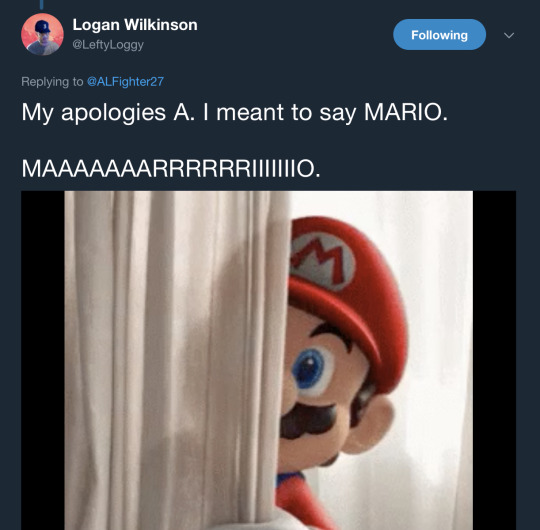
Um... Okay. Yeah dude. You do you. Glad you got a Switch and the Mario and stuff...
But really, a lot of playing Mario for me has been falling back in love with the Nintendo Switch as a platform. I’m curious what you think of it Logan! Glad you seem to be enjoying yourself!
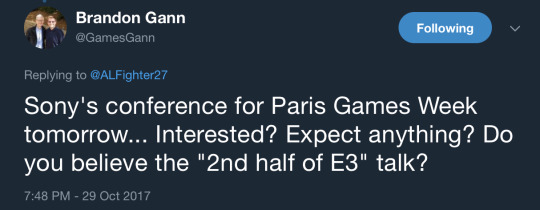
No. For sure not. I also didn’t really love their E3 showing, so who knows. I think Sony is gonna have some cool stuff to show, but I think the “Second half of E3″, if that is gonna be anywhere outside of E3, is going to be at PSX, especially after The Last of Us 2 drop last year. With Uncharted fully done now, we know Naughty Dog is likely all hands on deck with Last of Us Part 2. I cannot wait, with that in mind, even though it’s likely still 2019. But I think PSX will see the reveal of Sucker Punch’s next game, so I don’t know what that leaves for Paris Games week.
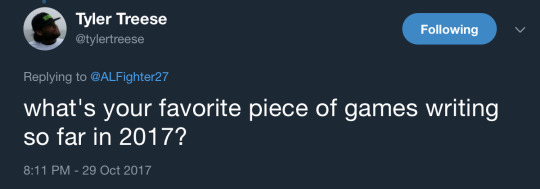
This is a great question! It’s hard to pin down, and I’m honored to say some of my favorite things I’ve read this year have been on IrrationalPassions.com. But outside of that, I wanna give a shoutout to Jason Schreier’s unveil of what went on with EA and Visceral, from this very week.
It’ll be in the Checklist section, but it’s kind of the first of these big exposés I’ve sat down and read all the way through in one sitting, and it was phenomenal. It really opened my eyes to the different kinds of struggles that studios can run into that I had no perception of at all. It’s a fantastic read, and an even better story.
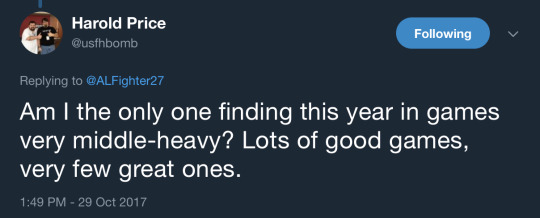
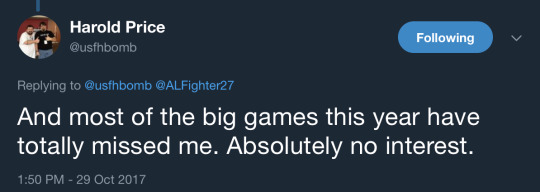
I mean, yes. And no.
Taking into account that I know you, and I know you don’t really like 3D games and games of that ilk, of course, yeah I get it. Taking those big ones out, games like SteamWorld Dig 2, Stardew Valley, HiveSwap, Shantae, and more can’t carry a year like the heavy hitters in the 3D space. But I think you have to take that step back and look at the wider "games” as a whole.
To use me as an example, I don’t like Wolfenstein nor do I plan on playing the new one, or Battlefront 2, or Call of Duty World War 2, those are the big games that don’t click with me, but that doesn't mean those games can’t be incredible, and just because I don’t like them doesn’t mean they’re not great or incredible, but my appreciation of them will be different. But that’s my critic’s perspective.
I think that’s okay, but I’d encourage you to keep trying those games you typically don’t like and search for something in them that you can find and enjoy. I’ll try the betas for Battlefront 2 and CoDWW2 and try and try and look for something I like even if I can’t find it, because I’d rather waste my time looking for the good then take the easy road of assuming the bad.
But eh. That’s just me being a goody two shoes as always.
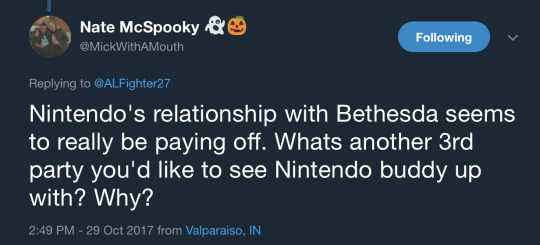
Yeah, it does! I would love to see that extend out to Bandai Namco! Getting games like Dark Souls, and the upcoming Code Vein on Switch would be excellent. But more over, I think they’d be shrewd, and quiet, like the Bethesda team up. Bandai Namco isn’t the biggest publisher, not even top three, but it covers another niche of games that Nintendo can draw to its platform. Those kinds of players maybe are to chopped on what system they play on, just how enjoyable that experience is. Going the obscure route has worked so well for them, and I think this could work to.
Plus I really want a Dark Souls remaster/re-release with some new features/better frame rate, and it being on Switch may be even better.
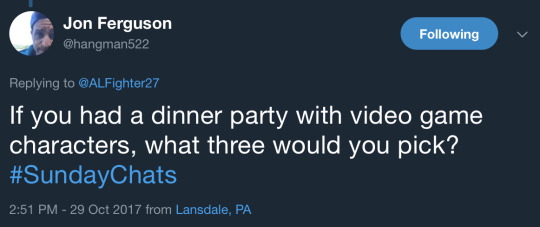
Princess Peach, Princess Zelda, and Samus Aran.
We’d have tea and crumpets, and discuss cute color combinations and space ships, because I think all four of us would have some broad, sweeping opinions on all of the above.
Another good one, a bit more serious, is Nathan Drake, Marcus Fenix, and... Well, Samus Aran again.
Can I just have a date dinner with Samus Aran?

It’s been crazy weird dude. I wish the world wasn’t in as rough shape as it was :/

Uhg.
Fuck.
This is a great question Miranda, but god fuck all of this.
Okay.
A wolf.
And hear me out, because the wolf would probably kill me a lot slower.
But the same shit with Octopi that is with spiders, which I hate. Octopi got too many legs, and I just don’t wanna fuck with it. And it’d be all slimy. And I know both would ultimately kill me, because Octopi do NOT fuck around, but I can like, imagine the Wolf is a cute fucking doggo and be slightly less sad about it.
Also like, then I’d get to see a wolf, which I’ve always wanted to see, and I never want to see the sea-spider for as long as I live.
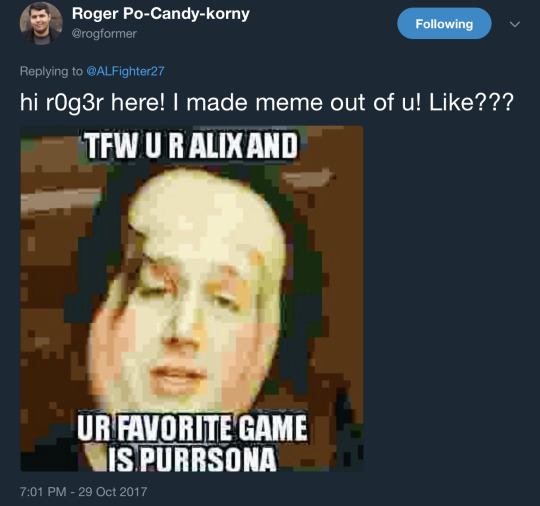


He is a v. v. handsome boy Cameron and you should be proud.
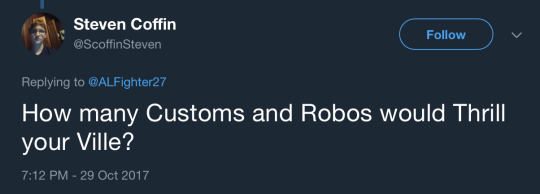
I’d say at least two customs, and one robo.
Because I know me.
I’m not selfish.
Save some Robot for the other kids.

I think it’s definitely up there. I love it for sure. I love that it’s doing something different on Netflix, and blending this weird nostalgia and referential material into a really cohesive and well made original thing with its own ideas and things to say.
And these latest season has a ton of Ghostbusters so I’m a fan.

This is so rad! For folks curious, here is the referenced article:
https://www.polygon.com/2017/10/28/16563612/destiny-2-deaf-clan-leviaithan-raid-calus
I just love this shit. I hadn’t seen it, but it shows the tenacity and ingenuity of players from all walks of life. What I’d really like to see, and it’d be hard to set up, but having all six players on six screens in the same room so the Shadow Realm folks didn’t need to say anything, and the ones outside could just look and know. It’d be super rad, and we may be able to do this at ExtraLife, but we’ll see.
I love making new and original solutions to problems, and just like I said with the whole jargon-discussion when we played the raid, this is this team making their own jargon for the raid.
The Checklist
The Collapse of Visceral’s Ambitious Star Wars Game - Jason Schreier - Kotaku - https://kotaku.com/the-collapse-of-viscerals-ambitious-star-wars-game-1819916152
This is the first one of these I’ve actually really read, at least since Klepek’s last one I would have read. And it was fascinating. I have so many thoughts and feelings on this piece, and I know Schreier has a book out about them, and did one for Mass Effect earlier this year, but this is the first one I’ve ever really sat down and read. And it’s phenomenal. And eye opening.
Orc Slavery Made me Quit Shadow of War - Matthew Gault - Motherboard - https://motherboard.vice.com/en_us/article/bjve9q/middle-earth-shadow-of-war-orc-slavery-lord-of-the-rings
This is so, so, sooooo good. I haven’t really read anything on Motherboard before, but being a close sibling to Waypoint, which has skyrocketed to my favorite video game site on the internet this week, I will tune in more after this. Shoutout to OK Beast Podcast episode 65 for bringing this up and reading an excerpt from this. It really hooked me.
Inside the Sexual Misconduct Allegations Rocking NEOGaf - Patrick Klepek - Waypoint - https://waypoint.vice.com/en_us/article/qv384d/inside-the-sexual-misconduct-allegations-rocking-neogafs-last-48-hoursd
This is a weird story for sure. And I wish i could talk to Patrick about it. It’s invasive, but it’s also incredibly well reported, and I think clears up a lot of the misconceptions in the situation. There are no biases in Patrick’s writing. It’s really excellent, and help me get a grasp of what went on on Gaf. And I appreciate it.
Whew, good to get in the swing of things again. I’ll say, we are two weeks out from ExtraLife, and I am going to assume there will not be a Sunday Chats that day. Sorry in advance, but I will try to get my “Alex-Asks-A-Question” style Sunday Chats done like normal next week.
But it’s been a fucking crazy month, and I am so happy to see all the hard work I put in this month come to fruition, and the next big thing is that ExtraLife extravaganza. I hope to see you all watching.
But until then
keep it real.
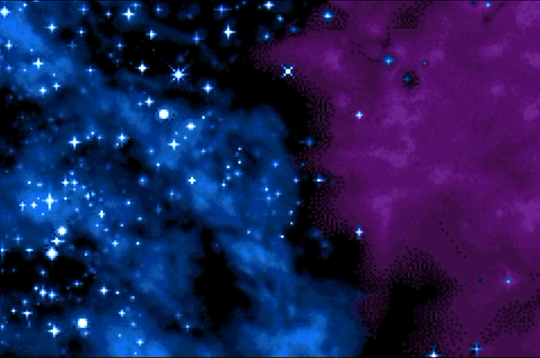
1 note
·
View note
Text
Decay of Logos Review
New Post has been published on https://gamerszone.tn/decay-of-logos-review/
Decay of Logos Review

There’s an old Wile E. Coyote cartoon where he gets in a racecar to chase after the Road Runner, and as he’s speeding along the car begins to fall apart piece by piece until he’s left holding nothing but a busted steering wheel. That’s what it feels like to play Decay of Logos, an open-world action-adventure RPG that strongly invokes The Legend of Zelda but is missing the crucial pieces that make the genre so beloved.
Drawing inspiration from Dark Souls as well, Decay of Logos places emphasis on challenge and exploration, though it rarely sticks the landing. Across its roughly 10-hour campaign you’ll travel through haunted battlefields, crumbling castles, and mysterious woods – all while fighting the same handful of generic enemy types over and over again in one of the most infuriatingly repetitive and buggy games I’ve seen in a long time. Whether it’s the choppy framerate, equipment that disappears from your inventory, the world not loading in time for you to step foot on it, or the whole thing crashing entirely, you’re only ever a short time away from something that will hinder or completely shatter your enjoyment of a game that otherwise has a lot of potential.

You play a bland, white-haired silent protagonist named Ada, who looks like an off-brand version of The Legend of Zelda’s Link. Accompanied by your equally silent companion, a white elk of unknown origin, you’ll set out on a cliché and low-stakes quest for revenge after your village is burned to the ground. Despite the generic plot, the worldbuilding in Decay of Logos is expertly done, making heavy use of environmental storytelling that gives you a taste of a dystopian fantasy setting and asks you to fill in the gaps. The colorful, Breath of the Wild-esque art style shows off some pretty stellar areas that beg to be explored, though doing so almost invariably ends in touring samey dungeons, filled with repetitive monsters and puzzles that you quickly become all too familiar with.
The Breath of the Wild-esque art style shows off some pretty stellar areas that beg to be explored, though doing so almost invariably ends in touring samey dungeons filled with repetitive monsters.
“
At the best of times, Decay of Logos simply runs poorly: The framerate bounces up and down wildly and makes gameplay choppy during combat encounters that require precise timing, and some nasty screen tearing can make the world look like a piece of abstract art. But where Decay of Logos really suffers is in the frustrating, intermittent critical glitches and bugs that completely halt progress. Traveling across long stretches of the open world without resting usually results in the framerate going from bad to nearly unplayable. Oftentimes areas of the world took too long to load in under my feet, resulting in me falling through the map and dying due to no fault of my own. Sometimes dying or resting to restore my health had the side effect of causing all my potions or one of my weapons to disappear without explanation.
These kinds of glitches were so commonplace during my playthrough that I had to come up with workarounds, like not pausing for more than a minute or two to avoid an inevitable crash that always seemed to follow. In another particularly maddening instance, I began to recognize that an extreme drop in framerate was a warning sign that the floor was moments away from disappearing – in moments like this I would race to a save point to avoid losing progress, often only to fall through the floor and die mere seconds from salvation.

And unfortunately, even when everything technically works, many of Decay of Logos’ design troubles rear their heads. The RPG systems that govern the world and its characters are vague and aggravating. For example, your character’s level, which greatly impacts how powerful you are and your ability to compete with enemies in certain parts of the world, can be found in the menu, but there’s no information on how much XP you have, how to get more, or how much you need to the next level up. This is particularly annoying because most enemies in the world arbitrarily become much stronger once you accomplish certain milestones, like killing a major boss, which leads to some really frustrating encounters.
Even when everything technically works, many of Decay of Logos’ design troubles rear their heads.
“
At one point I powered through an army of the undead and killed one of the major bosses without so much as a scratch on me, only to be killed by those same low-level minions on my way back to base, because the act of slaying the boss had leveled up every enemy in the world. This means that every time you beat a chapter, you go from powerful badass to near-useless dreg and have to grind until you level up a few times and become strong again, relative to the rest of the characters in the world. It’s a routine that’s far more irritating than it is fun, and made me feel cheated out of my hard-won progress at precisely the moments where I should have felt most accomplished.
Combat in Decay of Logos is also deeply flawed in that it pits you against the same handful of enemy types for hours on end. Each area has just one or two unique types of enemies that appear in large numbers, and in most cases they can’t be realistically dealt with in groups greater than two or three at a time. So victory becomes a matter of drawing the attention of a few enemies at once, killing them, and repeating. And because the leveling system often artificially makes enemies much stronger than you, combat can drag on for long stretches of time as you whittle down the health meter of an enemy that you might have been able to kill in a few seconds just a short time ago. The dynamic here is even worse when it comes to the world’s optional bosses, all of which are carbon copies of one another, and have predictable movesets and obnoxiously large health bars that make for tiresome encounters.
Last week, after publishing our original review of Decay of Logos, the publisher informed us that they had mistakenly provided us with an Xbox One copy that was two months out of date. We retracted the review to make sure we fairly represented the developers’ work and began again on PlayStation 4, using a new code provided by the publisher. But after playing through the entire game a second time, the experience was only marginally improved in stability and bugs. We are told further patches are on the way, including one on launch day, but it’s unclear what issues will specifically be addressed.
Of all the design issues I have with Decay of Logos, though, the elk is what enrages me the most. As you play, you’re frequently reminded about the importance of the bond between Ada and her elk companion, especially the need to cooperate in order to overcome obstacles. But that promise is never delivered on, chiefly because the elk is about as useful as a screen door on a submarine and has the AI of a refrigerator magnet. For starters, one of the main uses of the elk is the ability to ride it to get from place to place, but doing so is frustrating and inefficient. Not only can you run faster than the elk, but directing it is treated more as a suggestion than an order, and the beast mostly wanders around aimlessly and gets caught on everything in its path.
But the worst instances involving the elk are when you’re asked to solve a puzzle in tandem with it. Simply put, this dumb thing just doesn’t follow orders. You have the ability to call it by blowing a whistle, but most times it doesn’t show up or gets caught on something on the way to you and has to be manually guided out. In one instance, I spent several minutes trying to find the elk, only to find it undulating bizarrely on the side of a cliff, and I had to jump off said cliff to restore its sanity. In another example, I spent over an hour trying to guide it out of a spiral staircase that it’d gotten itself lodged under. They say if you listen closely, you can still hear my screams of rage to this very day.
Source : IGN
0 notes
Text
The Musou Genre Is Exactly Why We Should Want To Pay More For Our Games
I have to say: I’m absolutely loving Hyrule Warriors. It’s a musou-style game, a la Dynasty Warriors, for the Nintendo Switch (and originally, 3DS). While the main criticism of said games can be that they’re ultra repetitive (and they are), something also should be said of game intent, purpose and console aesthetic. While Dynasty Warriors has always felt too arcade-y for sitting on the couch, hyper-focused on playing a game, this iteration set in the Hyrule universe is really amazing on the oft-portable Nintendo Switch. My girlfriend and I play a round or two before bed, making it the perfect sort of mindless fun we can do together. Controls are easy to remember, objectives are simple, and the presentation is really well-done. Including characters that have a storied lineage really magnifies the intrigue of a musou and I’m actually delighted by the story too. Although the narrative isn’t quite on par with Zelda standards, the overarching plotline certainly holds up; it’s definitely more than I expected find in Hyrule Warriors, which is a great surprise.
And what brings me to this post today is to celebrate the concept of these “mindless” arcade games and to also examine how we can keep them apart of the gaming ecosystem. After playing through behemoths like FFVII: Remake and The Last of Us: Part 2, sometimes its easy to always want AAA titles that push the limits of hardware, design and expectation. However, sometimes it’s nice not being such an active participant within an interactive media.
Exhibit A: Hyrule Warriors. Sometimes the ingredients just mix well together. I’ve played several Dynasty Warriors, I’ve tried Samurai Warriors. And while I had a passing interest in some of the Gundam musou entries, I skipped ‘em due to poor reviews. However, after stumbling upon Hyrule Warriors, I’ve started doing some actual research on the genre and the fandom, and it really seems like musou is generally misunderstood.
On the podcast I enjoy, Sacred Symbols (paid patron), musou games came up recently and there was some discussion about how bloated the release schedule is. How can Omega Force keep releasing all this stuff? And on some of the reviews I read that knocked the games, one critic, in particular, mentioned that Fire Emblem Warriors is “as boring as all the other musou games.” Its a 40/100, the lowest grade by nearly 30 points. Without it (again, the shoddiness of Metacritic is exposed), Fire Emblem Warriors would be “in the green” and plainly above 70. When you do any good dive into some research on the genre, you’ll see a lot of people on the forums own several next-gen musou games. When one drops, people eat ‘em up. To claim that an entry is “boring like the others” is a bit too subjective my tastes.
One of the best comments I read was from a user who exclaimed he needed “something mindless” like “EDF” (Earth Defense Force) or Dynasty Warriors after he’d just finished Assassin’s Creed: Odyssey, a notoriously bloated experience. The idea that there are different games and different genres to be played at different times is something I love exploring. It’s like the varying flavors of a fine meal, or even a diet spread out over weeks, months or even your entire year. In gaming we talk about absolutes too much: which is the best console? Which genres do you play? What’s the game of the year? What’s your Top 5? There should be multiple answers to all of these, all the time. As we witness more and more toxicity in the games industry, I can’t help but think embracing a genre like musou could be the key to expanding our perspectives.
Now I don’t mean musou explicitly. I mean find your musou. Honestly, I’ll play any genre given the right circumstances. For someone who doesn’t play sports games, I would happily buy Fifa if you told me I had a crew who wanted to play it online. I never thought I could be into Rocket League, but Playstation made it free and then I went on to get the Platinum Trophy because my mates and I had such a good time. Things are highly elastic when it comes to games and their genres. But sometimes we see them as more rigid, and the only absolute here is that they absolutely aren’t.
Exhibit B: Maneater. Here’s a $40 game from Deep Silver that’s somewhere in that AA space. A lot of people knocked it for being repetitive, but again: let’s embrace it for what it is. Intention is often ignored when reviewing games and not only do critics need to work on this, but users too. People rely heavily on other people’s impressions of a game to know if it’s fundamentally fine. Ripping on something for being too repetitive, too short, or too confusing will turn people off. I’ll be the first to admit I stayed away from Fallen Order and Control because I read they had performance issues. While I eventually ended up doing FO as a gameclub with a buddy, my experience was 100% hindered by chugging framerates and long load times. I’m still disappointed I’ll be waiting for Control until I can play it on Playstation 5, but I know my enjoyment will increase ten-fold if I can be patient. But when a game like Maneater is designed as more of a quick pick-up-and-play title, is calling it “repetitive” very fair? Should it have been reviewed through a lens of “play through its entirety as quick as possible?”
Exhibit C: Ghost of Tsushima. The new Playstation exclusive drops this Friday (7/17) and critics are mostly enjoying it. Some of the “less than stellar” reviews I’ve seen, though, fault it for some shoddy presentation in the wake of The Last of Us Pt 2. Which, again, I think is unfair. Comparing Tsushima to TLOU2 doesn’t seem very applicable. TLOU2 is in a league of its own in terms of budget, scope and talent. While Suckerpunch is well-regarded, they are by no means Naughty Dog. Even Insomniac seems to have eclipsed them a bit, growing with nearly every game they release. Suckerpunch, in my mind, sort of knows where their playground is and sticks to it. Which, again, isn’t a bad thing. It’s been some time since I’ve played an open-world game that really drew me in. Ghost of Tsushima’s aesthetic seems ripe for picking, and when a critic mentioned that it doesn’t seem to break any new ground for the genre, I kinda have to throw my hands up and go, “So?” When’s the last time you got to roam Japan as a ghostly samurai? Doesn’t that maybe count as “inventive” enough? For example, if we got Grand Theft Auto, exactly as it is, but set in London, Tokyo, or maybe even Russia, I’d finally have an interest in the series. Somewhere international sounds tantalizing. What’s more is that Japanese critics seem to be loving Ghost and a lot of that stems from it’s overall design aesthetic. Most critics, anywhere, have said it’s a really beautiful game. Sometimes isn’t a game worth playing just because it’s stunning to look at? Rez Infinite is a prime example of something that is fleeting yet remarkable. The original PS2 game may be in the package, but it’s the Area X that’s the real prize and it’s absolutely less than a 30 minute experience. But that’s the thing: it’s an experience. In no way would I ever look at what’s being offered and go, “It’s too short.” Too short by what comparison? Did I love what was offered, yes or no?
As time marches forward, I can’t help but continually feel like games journalism is slowly deteriorating and fan expectations are completely out of whack. One look at the “price increase” debate clearly shows fans don’t understand capitalism, value, and scope. Colin Moriarity, from Sacred Symbols, very openly supports the debate that you aren’t going to see any CEOs trying to let go of their profits. The argument that games’ prices shouldn’t go up because people at the top are rich enough is completely against the entire framework of our society. The concept that businesses are meant to grow is completely fine, in my book, and as game prices haven’t gone up to reflect inflation, we could probably at least do that much for our industry, right?
I think the most tantalizing part of this argument is that not all games are profitable. As dev cycles become longer and more expensive, we need to give studios the ability to invest in smaller projects and maybe even risky ones. Without a bunch of overhead capital, we will see an industry that becomes totally stagnant, devoid of unique offerings. The big players will continue to hit hard and the money-makers will continue to roll out. So expect Assassin’s Creed, Fortnite, Call of Duty and Halo for the rest of eternity (plus whatever Naughty Dog does). For some gamers that’s probably totally cool and fine. But I’m not one of those players. I would mostly stop gaming if all I had to look forward to were games as services or check-box open-world games. These styles are popular because fans love the insane amount of hours they can pour into one investment. Publishers love them because recreating assets and scenarios gets pretty easy for the titles after a certain point. But this can’t represent the entire climate. While I didn’t love Death Stranding, I’m so happy it exists. I’m ecstatic that this game emerged and took as many chances as it did. I’m thrilled Naughty Dog was allowed to take the gambles it did with TLOU2. Even look at Dreams: every person who loves dreams should be embracing a $70 price point because that kind of experience will not exist if companies aren’t extracting profit. Because you know what else? Those money-grubbers will never let go of their profit. Our experience will diminish greatly before they see lower dividends. So consider paying in a way to ensure the industry thrives in the way you want to see fit. Which I think is the heart of the matter.
We control this industry. Don’t like MTX or DLC? Don’t buy it. Don’t want it in your face? Don’t purchase or support those games. If you’re like me and you want a wide genre of games available to you at all times, consider being pro-price increase. Also consider buying games right as they come out. Too many people pirate or wait for sales. Yet those are the same people not in favor of a price increase. Those types of consumers are already hurting the industry. Think of all the people getting fat on free content who never pay a dime for their games. Those people are also trying to weigh in on something they don’t really support to begin with. Publishers have been, ostensibly, trying to charge you nearly $100 per game for several years now with their Deluxe Editions and DLC. If you’ve ever thought this “price-gouging” was ridiculous, consider why it exists in the first place that isn’t related to the tired argument of, “they’re greedy.”
Games are a total luxury. And the people who will determine the future of this medium are the people who actually pay for this luxury. The argument that “you can’t afford it” isn’t appropriate, in my mind. While I sympathize with the notion that it sucks having to pay $60 or even $70 for a new game (especially one that might not be very good), you have to consider what these games cost to create. And if people want today’s offerings to be $20, $30 or $40, it’s simply not realistic. Additionally, we want all different kinds of games, too, right?
I do believe that’s the crux of the argument: I want to be able to play Hyrule Warriors, Sonic Forces, The Last of Us Pt 2, and Ghost of Tsushima. These games are not created equally. While TLOU2 might be a sales giant, Ghost is unproven. It’s got Suckerpunch behind it, but that’s a brand new IP coming out at the end of the Playstation’s lifecycle. If you want more games and more risks like this, you’ve gotta purchase the titles representing these decisions. I love that Hyrule Warriors and Fire Emblem Warriors both exist for me to play. If the ecosystem isn’t supported properly, we don’t get these options. We might get one huge hitter from the “Warriors” franchise instead of a handful. We might get one exclusive from Playstation in any given year. And the reason I emphasize this shrinking of the industry is because not only are publishers reaching for a price increase, but industry leaders have also come out saying things aren’t sustainable on a $60 per game price point. If you truly examine the argument, it just doesn’t make sense. I paid $60 for Killzone 3 on PS3 and TLOU2? No, that doesn’t add up. God of War (PS4) and Horizon Zero Dawn are valued the same as something like Homefront (PS3)?
The other side of this argument suggests that we could try and explore more price points... but I stand by the notion that Homefront probably did cost $60 at the time. It wasn’t trying to be a budget title. But as we’ve gone forward in time, gaming experiences have expanded exponentially. I truly believe that something like TLOU or Ghost probably do need to extract more than $60 from their users. Yet below that price point, there’s a lot more room for investigation. We need to see more Maneaters and Hellblades. Think of all the quality content Supergiant Games has made (Bastion, Transistor, Pyre, Hades) that have come out at “budget” price points... There is a great exploration of content type and price that can (and probably should) emerge as we head into the great unknown.
At the end of the day, I just love gaming. I love it. It’s my favorite thing in the world. And I want to see it thrive. The reality is that money talks. In my life I’ve seen only the benefits of paying for goods and services versus taking things for free or if they are offered at a steep discount. Great things should and do carry real value. We need to respect that value in all things. My hope is that the gaming community can see this in their hobby and start to respect it more. Because so far, anyone I’ve engaged with in this conversation, has not once said they pay full price for their games. I listed Doom Eternal on the Facebook Marketplace and people are upset I’m charging $30, free shipping, when the cheapest it exists on Amazon is $41 + shipping used. eBay is roughly the same price and Gamefly has a copy for $39.99 right now, used. I told one guy I just listed it and that I’d like to try and get $30 since it’s the cheapest I can find. He retorted, “Yeah, brand new maybe.” Doom Eternal is still $60 on Amazon, Best Buy and Gamestop. I know that my experience is in a vacuum-- all of our experiences are. But we need to discuss them so that the anecdotal evidence can tip in one way or the other. And this experience with Doom is not the first time I’ve witnessed gamers being completely out of touch with prices and value.
I used to work for a used goods store called Half Price Books. I learned full-on what the value of something is to a re-seller and the life cycle of an item getting marked down and potentially sent to clearance. For every product that sells at full price, several others go to the bargain bin. This means HPB was either breaking even or losing money on most items. Re-couping costs on those top-shelf commodities is essential to the business and it’s vital to most capitalist ecosystems. HPB can only survive thanks to the people who see an item they want, understand its value, and pay the price we initially set. Every company trying to sell you something is basically operating the same way. And what I also learned from HPB is that people don’t understand what their own possessions are worth. People would get upset a lot that we wanted to pay so little. Gamers have been facing this for decades with second-hand shops like Gamestop, EB Games and more. But what people fail to see is that most stuff is crap. And not only is most stuff crap, but if the good stuff does come around, the business officially has to make up for missed or lost sales somehow and your awesome item needs to be purchased and sold for a price point that helps the business.
Just take a look at TLOU2 versus Days Gone. Similar games, both exclusive first-party titles. One sold extraordinarily well, one did not. Playstation literally needs TLOU2 to dominate so a game like Days Gone can get a chance. While the profit numbers will show TLOU2 to be a massive hit, that money helps out in other sectors, bolstering the entire platform. The people who worked very hard on the game deserve those bonuses coming their way. They deserve the champagne glasses that say “The Last of Us Pt 2″ on them with commemorative decor. Imagine if you slaved away on something for your job and at the end your boss said, “Great job,” and that’s all you got. Don’t you want a pizza party? Or an extra check in the mail? Or even a new mug?
We gotta pay for the things we love so the things we love can continue being labors of love. Real people are needed to create the experiences we cherish so much and respecting them comes down to understanding the value of what we choose to play every day. If you comprehend the value of what’s on your big screen TV, paying more for games shouldn’t sting too much. Because if you’re anything like me, you don’t even have the time to buy every new game that comes out. I rarely pay full-price for a game because I’m so busy digging through backlog titles that have often been on sale for several months already. But when games like FFVII: Remake or Ghost of Tsushima do come along, I’m really happy to be first in line, paying the full-price of admission. I just wish more of my fellow gamers felt that way. Because I’ve heard all the other arguments; I’ve heard ‘em. I don’t buy into them at all. We vote with our wallets and whatever issues you have with the industry when it comes to “greed,” consider what you’re playing. I have had zero issues with microtransactions in my gameplay choices. If you, for some reason, are just appalled that MTX exists at all within a game, then I recommend you just check your baggage at the door. I paid full price for Persona 5: Royal which has all kinds of things I can buy on the side to bolster my experience. I haven’t touched those add-ons, I don’t plan to touch them and they, in no way, have affected me playing P5R. You can feel the exact same way and don’t need to be upset that MTX exists simply because MTX exists. The next time you see it, consider what you paid for the game you’re playing. If it was anything less than full price, MTX is a great way to try and recoup the money they lost on your discounted cost. And if you did pay full price, think of all the people who didn’t or won’t. MTX exists so Atlus can publish / localize the next Persona everywhere they intend to. It ensures we get killer voice actors, great translations, and cool spin-offs. It helps create a vibrant community, something that exists well outside the bounds of the original game even.
Really, I just want the best game possible. All the time. When I play a really awesome, beautiful game, it usually takes my breath away. I’m consumed by it; totally entranced and in-love. To me that can cost more than $60. I spent 80 hours with FFVII: Remake. 80 hours, man. I was blown away for every second too. For about $100 a night + food, drink and excursions, I can go stay on a beach for the weekend. That’s easily around $500+, if not more. While they’re completely different experiences, FFVII:R had years of nostalgia baked into the mix. I would choose to play FFVII:R over many, many other kinds of experiences. Microdermabrasion? $80+. Date-night with a new fling? Easily $100+. 30 minute massage? $40 + tip. FFVII:R gave me 80 hours of pure joy and all I paid was $60. That’s a steal.
Just consider what you’re really getting when you buy your games. And if you feel like you’re already in my camp, then please share the love. I wanna know where my crew is at; where the homies are. Because video games are incredible. And the way the conversation is breaking down about price increases, it’s hard to tell if some people actually love games the way I do too. When you really love something, you want the best for it; you aren’t cynical towards it. It’s my belief that the games industry, by and large, is not out to screw us, it’s just trying to find ways to be viable for years to come. If you don’t like the way it’s trying to thrive, don’t support those ways. But you gotta support something; saying that games need to be “cheaper” isn’t really an option. Because games have never been much cheaper than this when you factor in inflation. We got to have our cake and eat it for a long, long time. Now we gotta pony up.
0 notes
Text
The best Nintendo 3DS games you can buy
The Insider Picks team writes about stuff we think you'll like. Business Insider has affiliate partnerships, so we get a share of the revenue from your purchase.
The Insider Pick:
The Nintendo 3DS is a great handheld gaming console with many fun games. We've rounded up five of our favorite 3DS games to help you build your collection.
Nintendo wrote the book on portable gaming with the release of the classic Game Boy in 1989 and the company has kept the handheld market all but cornered since then. The original Game Boy, as well as its successors – including the Game Boy Color, Game Boy Advance, and Nintendo DS – all boast great libraries of exclusive first- and third-party titles. And while it got off to a somewhat slow start following its 2011 launch, the 3DS, Nintendo’s latest handheld console, might just be the best portable gaming system yet.
The beloved Japanese game company is nothing if not innovative, and in 2004 Nintendo re-invented the wheel with the unique DS handheld which featured a dual-screen design (hence the name) with a lower touch display. The format proved to be a hit with gamers. The DS sold more than 150 million units worldwide. The 3DS carries on this basic format with one major addition: stereoscopic 3D that lets you view your games in three dimensions without the need for any special eyewear.
Although this 3D feature was greeted with some skepticism by many, there’s no denying that the Nintendo 3DS delivers where it counts: the games. The 3DS has built up an incredible library of awesome exclusives over the past six years, from first-party franchises like Mario and Animal Crossing to third-party hits like Pokémon and Fire Emblem. Don’t turn up your nose at the stereoscopic 3D, however. The redesigned New Nintendo 3DS added a face-tracking feature which greatly improves the stability of the three-dimensional visuals, and this really shines in certain games for a truly unique and visually dazzling experience.
Whether you’re new to the 3DS and are looking to jump on the handheld bandwagon (if you haven’t already, then now is the time), or if you’re already a proud owner of Nintendo’s latest handheld and simply want to know that the must-have games are, our guide has you covered: We’ve pared the 3DS lineup down to what we consider the five best titles that every handheld gamer should have in their collection.
Our favorite Nintendo 3DS games include "Super Mario 3D Land," "The Legend of Zelda: A Link Between Worlds," "Animal Crossing: New Leaf," "Pokémon Sun," "Pokémon Moon," and "Fire Emblem: Awakening." Read on to see why we love these titles and to decide which ones pique your interest.
The best platforming game
Nintendo
Why you'll love it: “Super Mario 3D Land” has all of the coin-collecting, baddie-stomping, platforming action you could possibly want from a Mario game, along with perhaps the best level design seen in the series since “Super Mario 64.”
Our favorite red-clad mustachioed Italian plumber has had a long run, dating all the way back to 1981 when he made his debut in the arcade classic, “Donkey Kong.” Then, a few years later, players were introduced to the game that would come to define a whole genre of platforming games. 1985’s “Super Mario Bros.” became an instant hit worldwide, spawning a franchise that enjoys massive popularity to this day.
Nintendo has continued to experiment with the Mario formula over the years, producing a myriad of sequels and spin-offs that include everything from puzzle games to RPGs. You can’t beat a classic, however, and Mario still shines brightest when Nintendo sticks to the fundamentals of what made him so popular in the first place. “Super Mario 3D Land” is a shining example of this and earns its place as possibly the best core Mario platforming game since “Super Mario 64.”
Visually, “3D Land” features timeless Mario aesthetics that hark back to “Super Mario Bros. 3” and “Super Mario World” with a dash of “Super Mario 64” thrown in for good measure. And while many were initially unimpressed with the Nintendo 3DS’s stereoscopic 3D feature, it shines here.
There are levels where you will absolutely want to turn your system’s 3D all the way up in order to fully experience the world and art design. For example, some stages feature particle effects, and when you activate the stereoscopic 3D, the particles appear to “float” above the 3DS screen as you play. It’s really quite stunning at times and proves that this 3D feature is far from a gimmick.
In terms of gameplay, “Super Mario 3D Land” feels the most like “Super Mario Bros. 3,” complete with flying battleships and the famous Tanooki Suit, along with some new additions. The world design hits a perfect sweet spot between 2D side-scrolling and 3D exploration.
Certain stages are set up like the old-school Mario games, where you run from left to right, although with an added third dimension that lets Mario move around from front to back. This makes for unique multi-layered level designs that put a three-dimensional spin on the old two-dimensional formula. Other areas play more like those found in newer Mario games, where you move and explore in 360-degree open environments, and many of these angles the camera in unique ways to create visual depth that is only amplified by the stereoscopic 3D.
“Super Mario 3D Land” also boasts what is easily some of the best level design and world-building we’ve seen since “Super Mario 64.” The gameplay is extremely addictive and should keep you busy for awhile; even after you beat it, remixed challenge stages await to offer you plenty of replay value.
All of this makes “3D Land” one of the best core games in Nintendo’s long-running flagship series, one of the most fun platforming titles of all time, and an absolute gem for any 3DS owner who still can’t get enough of Mario’s brick-breaking, coin-collecting, princess-rescuing goodness.
Pros: Some of the best level design seen in a Mario game, a fun and catchy soundtrack, great 3D effects, and highly addictive gameplay
Cons: Lacks the interesting overworlds seen in previous Super Mario titles
Buy "Super Mario 3D Land" on Amazon for $31.47
The best action-adventure game
Nintendo
Why you'll love it: With classic old-school gameplay and fantastic dungeons, “The Legend of Zelda: A Link Between Worlds” is a long-awaited sequel that lives up to its legendary SNES predecessor.
Like Super Mario, The Legend of Zelda is another decades-old Nintendo series that remains beloved by millions. It got its start on the NES with “The Legend of Zelda,” the game that laid down the basic formula, but the breakout hit that really put this action-adventure franchise on the map was “A Link to the Past” for the Super Nintendo. “The Legend of Zelda: A Link Between Worlds” is the highly-anticipated sequel to the SNES classic, and Nintendo has once again delivered a stellar game that more than met players’ expectations.
The Zelda series has a long and varied history, and Nintendo continues to out-do itself with each new installment. It first made a jump into 3D on the Nintendo 64 with the hugely popular “Ocarina of Time,” and most of the core Zelda games have followed this new format with great results.
With “A Link Between Worlds,” however, Nintendo returned to the birds-eye-view perspective first seen on the NES and SNES. It’s a fitting choice given that “Between Worlds” is a direct sequel to “A Link to the Past,” and, as good as the newer Zeldas have been, it goes without saying that the traditional formula still works: “A Link Between Worlds” is an absolute joy to play and illustrates that some things simply never get old.
Gamers who enjoyed “A Link to the Past” will be in familiar waters here. “A Link Between Worlds” boasts updated 3D graphics, but the old-school gameplay elements are all there (with some new additions, naturally).
You’ll roam around Hyrule fighting baddies – classic Zelda music playing in the background – when you’re not venturing into wonderfully-designed new dungeons filled with puzzles, rupees, and bosses. At first glance, the game looks and feels a lot like its 16-bit counterpart, and fans of the original will have a lot of fun re-visiting the old instantly-recognizable overworld and seeing what’s changed since Link’s last adventure.
“A Link Between Worlds” adds a whole new spin to Hyrule, however, with some novel mechanics paired with the ability to travel to Lorule, a dark mirrored version of the normal game world. Lorule contains its own unique set of enemies, dungeons, and challenges for you to complete. The familiar Zelda tools and weapons are there for you to play with, but this time around, Link has a few new tricks up his sleeve, such as the ability to transform into a flat 2D image in order to solve certain puzzles.
You can also buy your power-ups at any time, which allows you to complete dungeons in any order. These new elements breathe new life into the old formula and blend seamlessly with the classic gameplay, crafting an experience that is both fresh and nostalgic without getting bogged down in fan-service.
Although the newer 3D Zelda games have been fantastic (many critics, including Peter Brown of GameSpot, have hailed “Breath of the Wild” as the greatest Zelda game ever made), “A Link Between Worlds” is an incredible entry in the series and a serious treat for old-school fans. It’s not only possibly the best 2D Zelda title to date, it’s also one of the best entries in the entire franchise and a must-play for veterans and newcomers alike.
Pros: Classic 2D Zelda gameplay, seamlessly blends the old and new, a great soundtrack, and brilliantly-designed new dungeons
Cons: The old-school formula might appear dated to some
Buy "The Legend of Zelda: A Link Between Worlds" on Amazon for $41.62
The best casual game
Nintendo
Why you'll love it: Handheld games are great for relaxing and it doesn’t get much cozier than “Animal Crossing: New Leaf,” a charming life sim that appeals to all ages and feels right at home on the 3DS.
Animal Crossing is an interesting franchise that is difficult to describe to the uninitiated. Each game follows the same basic blueprint: You move into a new town, buy a house (home loan and all), and then carve out a happy existence as the only human in a village filled with friendly anthropomorphic animals.
You can fish, collect fossils, go shopping, gossip with your neighbors, celebrate holidays, and expand your house as you pay off your mortgage, to name just a few of the many activities that await you. You can even invite your real-life friends to visit your town (and you can visit theirs) through online play.
It doesn’t exactly sound like riveting, edge-of-your-seat gameplay, but Animal Crossing is packed with a unique and addictive charm that makes it difficult to put down. Although it got its start on consoles (it was first released in Japan for the Nintendo 64, then ported to the GameCube for Western audiences), this series really feels at home on handheld systems.
“Animal Crossing: New Leaf” is the latest core entry and, along with easily being the best Animal Crossing title yet, is also one of the most fun and endearing games to be found on the Nintendo 3DS.
“New Leaf” isn’t a major departure from the standard Animal Crossing format, but after three previous games which were all quite similar, fans will be pleased to see some major new additions. The most notable of these is that your character is quickly made mayor of your new town, giving you the power to enhance the village with public works.
You can commission simple things like benches, signs, and lamp posts as well as larger ones like shops, a cafe, and various remodeling projects. This adds a nice new layer to the classic gameplay, letting you customize your town. However, placing new landmarks feels a little clunky at times, and it can take a few tries to get things just how you want them.
One of the highlights of the series has always been expanding and furnishing your home – leave it to Nintendo to actually make paying your mortgage fun – and this system is expanded upon in “New Leaf,” which sees the raccoon merchant, Tom Nook, now running his own real estate agency. There are many ways to earn in-game money, or “bells,” in order to pay your debt and buy things, although the tropical island in the game almost makes this too easy.
Daily trips to collect tropical fruit and rare bugs are a quick way to net a ton of cash, which was likely made easier in order to help you pay for the new town projects. However, it does hamper some of the satisfaction found in previous games where it took a bit longer to fully pay off and expand your house.
All in all, however, “Animal Crossing: New Leaf” is an absolute gem and the new features are a joy to experience. The game, just as much as others in the series, appeals to players of all stripes and ages. And while you can play it on your 3DS pretty much anywhere, the wonderfully relaxing and cozy atmosphere of “New Leaf” is perhaps best enjoyed indoors on those rainy or chilly days when you’re wrapped up in a blanket with your favorite hot drink on-hand.
Pros: A myriad of welcome additions to the Animal Crossing formula, expanded house- and town-building features, a comfy and relaxing atmosphere, and charming characters
Cons: Earning money and buying everything in the game is almost too easy, and the public works feature feels awkward
Buy "Animal Crossing: New Leaf" on Amazon for $27.95
See the rest of the story at Business Insider
from Feedburner http://ift.tt/2zihC4h
0 notes